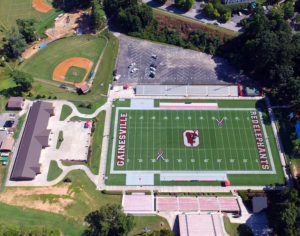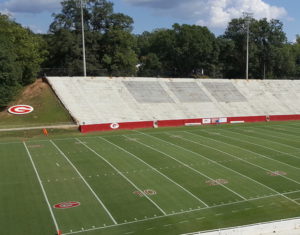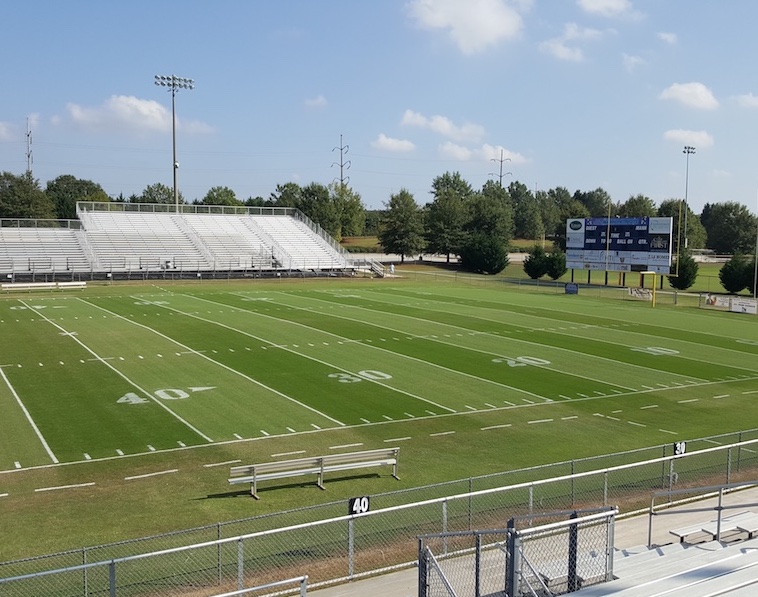By John Kmitta
Managing a large K-12 school district – and a high number of athletic fields, facilities and grounds over a wide geographic area – presents plenty of challenges and considerations under “normal” circumstances. In a 2020 that, of course, has been anything but normal, sports field managers are facing a whole new set of challenges and are rapidly adjusting to the circumstances.
The “typical” day and “typical” challenges
Although, even during a “typical” year, there is probably no such thing as a “typical” day, there are some common challenges shared by K-12 sports field managers.
David M. Presnell, athletic fields manager, Gainesville City Schools (Ga.), said that, under normal circumstances, his usual challenges are like those of most other sports field managers.
“We have a large number of fields to manage with a set number of staff and budget,” said Presnell. “The demand for usage and the increasing demand for non-sporting usage is a challenge.”
Again, under normal circumstances, Presnell said that his typical day would vary greatly depending on the season.

“Most of our schedule is dictated by athletic schedules,” said Presnell. “I try and take a long-range and consistent approach . While most people only see a field on game day, the bulk of the work takes place months before. We believe in doing things right the first time and staying on a consistent yearly turf management schedule.”
Jody Gill, grounds coordinator for the Blue Valley School District (Kan.), and immediate past president of the Sports Turf Managers Association, is responsible for 105 sports fields (six of which are synthetic), including stadium fields, high school practice fields, middle school football fields, elementary soccer and multipurpose fields.
“The concerns are the typical concerns, and that is a combination of overuse due to high demand and reduced inputs,” said Gill. “We are all facing budgetary issues, so no one can have everything they want. It’s challenging and we have to get very creative.”
Gill added that there is lot more crossover than there used to be with regard to the tasks his crews perform. Crews that typically mow the lawn areas around buildings will in some cases also mow some sports fields. And crews that typically mow sports fields will mow some lawn areas near high schools or sports complexes.
Shane Windham, coordinator of athletic fields and grounds, Greenville County Schools (S.C.), and his crews manage 130 total fields (across 20 middle and 14 high schools) and will be gaining six more next year with the addition of a new high school.
Windham’s biggest challenges are usually related to logistics, with 34 different sites spread over 800 square miles, and typically 34 different schedules (home, away, varsity, JV, C-team, D-Team, practices and games).
“Under our grounds umbrella is all the asphalt, sidewalk, block and concrete work; all storm drainage, retention ponds, underground piping; all decals and signage for the school district; fencing; 230 acres of irrigation; a sewer treatment plant; tennis courts; running tracks; hazardous tree removal; heavy equipment work; maintenance and construction contracts; maintaining school grounds; ADA compliance issues; all the playgrounds at 58 elementary schools; and many other administrative tasks,” he said.
Windham added that managing those logistics would not be possible without good people.
“Luckily, I have a lot of guys that have ‘bought in,’ and care about their jobs and the impression they make,” said Windham. “Without them, there’s no way I’d make it. I have a good foreman who has a ton of experience, and handles a lot of the non-routine jobs and keeps everyone on task. I just step in when out-of-the-ordinary problems come up, which is usually a once-a-day thing with all that we have.”
Windham said his team constantly works on keeping a system in place to stay up on everything and not let the small stuff slip through the cracks. “Our work order system along with Google Docs, help tremendously,” he added.
In terms of managing schedules and tasks, Blue Valley School District has a specific person assigned to each of its high school facilities and that person has multiple sites for which they are responsible.
“We ask them to stay on top of things and keep us informed of any issues,” said Gill. “They have regular routes that they follow. They are what we call high school stadium sports groundskeepers and they handle the grounds and facilities portion.”
Blue Valley School District also has a couple certified chemical applicators that have complete control of the equipment and materials for application of fertilizer and pest-control materials.
“We have to deal with more seasonal labor than we used to in order to reduce costs,” said Gill. “There are some additional training issues that go with that, and not always a high level of stability. There is more turnover with seasonal and temporary employees, so that creates issues.”
But usage is the biggest challenge – not only in stadium facilities, but also at elementary multipurpose fields, Gill reiterated.
“The kids might be on them for recess all day long and then the community is on them all evening and weekend,” said Gill. “None of them are fenced, so controlling access is impossible. But they still have to be maintained.”
Synthetic turf
Another challenge some K-12 sports field managers face is pressure to remove natural turfgrass fields and replace them with synthetic turf playing surfaces.
“We are fortunate that we have some pretty savvy taxpayers around here who do not necessarily agree with financing synthetic turf over a long period of time,” said Gill. “When you include the cost of a synthetic turf field in a bond project for example, you might be repaying bonds over a 10- to 30-year period.”
According to Gill, most sports field managers could argue that they don’t spend nearly as much on natural grass fields as some would lead others to believe.
“When you consider the cost of a synthetic turf field is, give or take, $1 million, it doesn’t make a whole lot of sense in many cases,” Gill added. “There are some exceptions. If you’ve got a football stadium that gets a huge amount of use, a synthetic turf field might make more sense. But people have to look at their own situations and decide if it makes sense or not.”
In the case of Blue Valley School District, with more than 100 fields, the cost per acre for maintaining natural grass is quite low, Gill added.
“So that is another thing people need to factor in as well,” he said. “They also need to recognize that there is maintenance associated with synthetic turf surfaces that you can’t ignore. It takes skill and knowledge to extend the life of those fields. It has to be managed, maintained and make sure you are GMAX testing and controlling the softness of that field over time to extend its life for the benefit of the taxpayers and the users.”
Windham said he is fortunate that his area has a long growing season for bermudagrass.
“With some overseeding, along with a strong maintenance program to have the fields in great shape during football season carrying it into the spring, our fields hold up pretty well,” he said.
He added that safety issues would be the only reason to possibly entertain a synthetic field due to the amount of usage.
“We also try to communicate to the athletic directors about moving things around, watching the amount of practice on the game fields, and trying to limit outside activities like PE classes going out on the game (football/lacrosse/soccer) field,” he said.
“First, for our school district, even though it is huge, the upfront cost for synthetic turf at 14 high schools is more than enough to make anyone nervous,” said Windham. “Second, I make sure they understand that synthetic turf is not maintenance free. Third, I let them know that, in a perfect world, they may get 15 years out of a field, but more likely 10 or 12. Then you are looking at another round of high-priced synthetic going in again. With what we spend on maintenance of the fields, it just doesn’t add up.”
Windham added that he is glad to say that he doesn’t have any synthetic turf fields.
“My advice would be to be educated on both surfaces and try and have a seat at the discussion table,” said Presnell. “Both surfaces have their place. The key is to approach the discussion as a professional. It all depends on the situation. You have to educate the decision makers on the falsehood of artificial turf lasting forever and you don’t have to do anything to it. A lot of districts change because they do not have the resources or staff to properly maintain natural surfaces. This is why turf professionals are so important.”
The “new normal”
Of course, with school closures and shelter-in-place orders, sports field managers have had to adjust the way they approach their duties and the way they plan for the coming days, weeks and months.
As of right now, it is business as usual for Windham and his crews, even though their schools are closed.
“We are able to put one employee per vehicle, and for most of what we do, our employees are definitely distanced from each other,” said Windham. “Plus, we are outside and probably better off than most who are forced inside or are in shared spaces. There is a system in place for letting us know if an employee may have been exposed to the coronavirus. Those are handled on a case-by-case basis, which have been few, and all negative so far.”
Windham added that planning has taken place for if they get shut down completely.

“Of course, plans do change, but we are looking at possibly dividing up the crew into one-day-a-week shifts, on-call lists, seeing if there are other “essential” tasks they can be a part of, whatever can be done to help get them time and a paycheck without putting them in harm’s way,” said Windham. “Unfortunately, our field maintenance may suffer a little due to cutting back on some of the daily maintenance, mowing specifically, but it will not be let go to the point of it causing a major issue. This soon will pass, and we will have to be ready.”
“The uncertainty of the situation is what’s so hard,” said Presnell.
Said Gill, “We are fortunate that we have been deemed essential, so my crew is back to work. We are making every effort to avoid contact. When guys come to the shop, they go straight to their assigned truck, load their equipment, and go. We are not meeting, we are not going into the building. If they have to use the restroom, they have instructions on how to go about that in order to keep the buildings clean. The health and safety of our staff is number one.”
Gill added that they are also focused on providing only the basic maintenance.
“We are doing weed control in landscape beds, but we not pruning landscapes, we are not trimming trees,” he said. “We are not doing extra mowings like we normally would do on higher-end athletic fields. And we are doing it without our seasonal staff. It is only our full-time staff, and some of our custodial staff members are assisting us as well.”
He added that they continue to whittle down the amount of mowing needed by choosing acreage that they can let go.
“If it is a fescue area that is in pretty good shape, we can let it grow taller and not worry about mowing it right now,” said Gill. “We can come back this fall and use a brush hog to knock it down and reseed those areas. Obviously, these are not front lawn areas and these are not athletic fields. But anything we can do to reduce the amount of time our staff has to spend at work is what we are really focused on right now.
“But our concern was that if we do nothing our expense to recover from that would be huge. So we found the ability to strike that balance between safety and effectiveness and continue to maintain properties minimally,” he added.
According to Gill, the challenges sports field managers have dealt with in the past – how to maximize the staff and the equipment that they, and how to be more efficient and more effective – are the same challenges they have now, just compounded.
“It amazes me how creative the people in our industry are, and how creative sports field managers are in dealing with these issues,” he said. “We are all just ready and willing to share information, and that is going to be really critical over the next few months as we recover from all of this.”
John Kmitta is associate publisher/editorial brand director of SportsField Management.
[Editor’s Note: The interviews for this article were conducted in late March and early April, 2020.]

